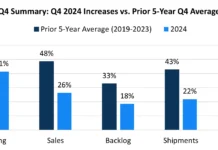By Chris Kuehl, managing director, Armada Corporate Intelligence
There always is something happening in the economy guaranteed to make a fool of economists. After all, the only function of economic forecasting is to make astrology look respectable.
For most of last year, the predictions were some versions of gloom and doom, and every quarter there was further evidence of growth (5.2% in Q3 and around 2.4% in Q4). Now there is debate over what to expect in 2024. There are those that are calling for a shallow recession in the first half of the year (-0.9% in Q1 and -0.7% in Q2). On the other hand, there are those that see decent growth in the first half of the year but a slower end to 2024. The Armada models seem to be favoring the latter interpretation.
Growth Drivers
There have been four drivers of growth over the last few quarters. These have been responsible for the performance in the third quarter and fourth quarter of last year and seem to be factors now as well. The fear is that two of the four already are showing signs of retreat and the other two will be facing some challenges. These also are significant drivers for the construction business.
Consumer Spending
The first is consumer spending, which has been performing well above the 20-year trend line despite the fact consumer debt is sitting at record levels ($7 trillion in credit card debt and $20 trillion in overall debt). The latest retail numbers were far better than expected with a reading of .63 compared to .15 in November. At the moment, the bottom third of income earners are living paycheck to paycheck and the middle third is starting to feel the pinch as well with 55% living paycheck to paycheck, but the upper third still is spending aggressively. The crucial factor for consumer spending is employment. As long as people feel secure in their employment, they will continue to spend and access credit. With the jobless rate still at 3.7%, there is not a lot of employment angst.
Non-Residential Construction
The second driver has been non-residential construction. It has been growing for several years now, but the industry is starting to worry about the pipeline in 2024. Many of the large projects that drove growth have been completed and there have been few new ones undertaken. There is one major factor on the horizon, and it relates to the third driver for the economy – government spending. The money that flowed out of the government to cope with the pandemic has been dispersed but two years ago there was a surge in allocating money for infrastructure with the CHIPS Act, Inflation Reduction Act and others. This money now is starting to flow as the states and communities have been kicking in their share. This will be a major motivator for non-residential construction as long as these projects are linked to infrastructure.
There still is not much movement in office development or retail but medical development is making a comeback, and the logistics business remains strong. There also is significant growth in the manufacturing sector as there still is interest in reshoring with further investment in robotics and technology.
Government Funding
The third driver already mentioned – government money – was starting to be a factor at the end of 2023 and will make its presence known in 2024.
Supply Chain
That leaves the fourth driver, which is the inventory build triggered by the challenges in the supply chain. The supply chain chaos of the last few years convinced many that the JIT system was broken and that inventory hold was necessary. There has been a dramatic increase in inventory accumulation as businesses no longer trusted the ability to get products when they needed them. That inventory build drove third-quarter expansion. Now these inventories are fleshed out, and the reorder cycle is starting to reassert itself. That will slow some of the accumulation that had been taking place. On the other hand, the recent issues in maritime transportation have started to push the supply chain crisis back to the forefront.
Other Considerations
The fact is that factors such as a reduction in interest rates by mid-summer can alter these assessments. There also can be negative factors playing a role – surge in joblessness, higher priced commodities, further trade tensions and maybe even a reaction to the political situation in the US.
All four of these drivers affect the plastics sector – in positive and negative ways. Fortunately, the good news has been outweighing the bad for the last few quarters, and there is some expectation this trend will continue. Every month there is an expectation that consumers suddenly will wake up and realize they are in debt to their eyebrows, but the data is not yet supporting this. There is, however, a clear division appearing between the upper third of income earners who have barely seen their spending patterns alter and the lower third where 85% are reporting they are living paycheck to paycheck.
The second driver has been showing more resilience than many expected as home starts are up – at both, the single- and multi-family levels. The key thing to recognize is that growth has been occurring in some parts of the country and often at the expense of others. The growth sectors have been seen in the southwest and southeast, while populations have been exiting the west coast and northeast. The prime motivation for this migration seems to have been the cost of living issues.
The bottom line is that 2024 is starting better than many had expected. The big question now is when will interest rates come down, and that depends on the inflation question. The rate of inflation has fallen to 2.5%, but that decline has been connected mostly to energy and food – notoriously volatile. As long as wages still are rising there is the continued risk of the wage/price spiral, and that worries the central banks.
Chris Kuehl is managing director of Armada Corporate Intelligence. Armada executives function as trusted strategic advisers to business executives, merging fundamental roots in corporate intelligence gathering, economic forecasting and strategy development. Armada focuses on the market forces bearing down on organizations.
More information: www.armada-intel.com





